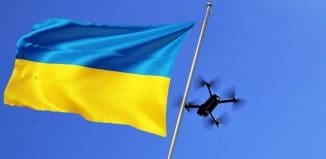Active Camouflage To Make Drones (Almost) Invisible
This post is also available in:  עברית (Hebrew)
עברית (Hebrew)
Being far smaller, and with the added benefit of having quiet electric motors, modern drones are a lot less conspicuous than their manned predecessors. But they are still not undetectable, not by a wide margin. Even with their small wingspan, UAVs can be easily spotted when their colouring contrasts sharply with the background behind them – the sky.
In a brilliant case of biomimicry, British company Plextek might soon make drones much, much harder to detect. Many animals have evolved a defense mechanism called counter-shading. Their furs or skins are far lighter underneath than on top, which reduces visibility produced by shadows.
Plextek are not the first to experiment with the idea. Prototypes were built and trials were run during World War II where planes were equipped with powerful spotlights on the fuselage’s lower half. The technology proved too cumbersome for application and never took off.
Another project, codenamed Compass Ghost, tried to revive the concept during the Vietnam war. US F-4’s were painted in special grey scheme, with nine lamps fitted. The range at which the planes could be detected was reduced by up to a third, but the technology was not yet mature enough.
Now come Plextek with idea that might just work. They have developed a novel application for e-ink displays that has the potential to make drones all but disappear from sight. The displays are monochrome, meaning they cannot mimic the colour of the sky above and behind the drone, but that really shouldn’t pose a problem. Specialty filters can provide shades of brown and green, and as Plextek director Nicholas Hill says, for aircraft camouflage is not a matter of colour but of luminance. An aircraft is visible when its brightness contrast sharply with that of the sky. E-ink displays allow that to be modified quickly and easily.
For now, the panels are assembled onto the wings, and in-flight testing is still to come, but Plextek envisions that the panels could one day form the wing rather than be added to it. The technology might not make drones invisible, but it will sure make them harder to spot.




























